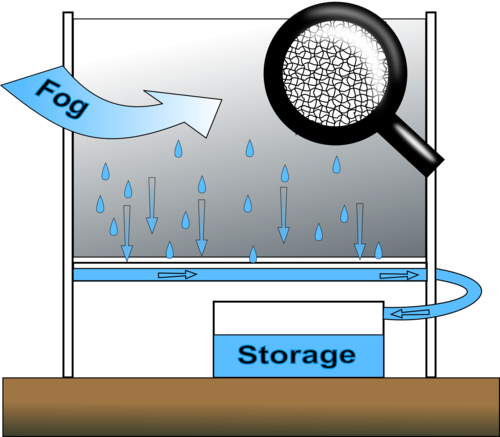Fog harvesting
A very special kind of water harvesting represents fog collection. This resource should be considered in areas where other traditional sources of water, for example surface water, wells or rainwater collection, cannot meet the needs of the people and where a water pipeline or desalination plants are impractical or too costly. The project costs are small, the technology simple, the water of very good quality, and the source sustainable for periods of hundreds or thousands of years. (Schemenauer & Cereceda 1997)
A fog collector is a simple frame that supports a section of mesh in a vertical plane. As the fog moves through the net, tiny fog droplets accumulate on the mesh and join to form larger drops that fall under the influence of gravity into a trough or gutter at the bottom of the panel, from which it is conveyed to a storage tank or cistern. The large, operational fog collectors are typically made of two supporting posts as well as cables on which the mesh is suspended. In addition, there is a network of guy-wires to support the posts, a plastic trough to collect the water, and pipes to move water from the troughs to a reservoir or cistern. The large collectors are usually 12 m long and 6 m high. The mesh covers the upper 4 m of the collector. This gives a collecting surface of 48 m2 and typical water production rates of 150 to 750 liters per day depending on the site. Alternatively, the collectors may be more complex structures, which is made up of a series of such collection panels. (Gur & Spuhler 2016)
There is number of meteorological and geographic considerations that is important when choosing a site for installation. For example, global wind patterns may result in a predominant wind direction and the altitude range of the clouds must be below the maximum terrain heights. In general, a mountain range perpendicular to the prevailing winds and high enough to intercept the clouds is needed. In case of coastal cloud decks, the mountain range should be within 5 or 10 km of the coast while the mountains or hills must have sufficient space for the fog collector array. There should not be any major terrain obstacle upwind of the site and moreover, the microtopography on the ridge or mountain affects the fog collection rates. Collectors are normally located on the crest lines of ridges or slightly upwind. (Schemenauer & Cereceda 1997)
Read more about the application, advantages and disadvantages of fog harvesting.

